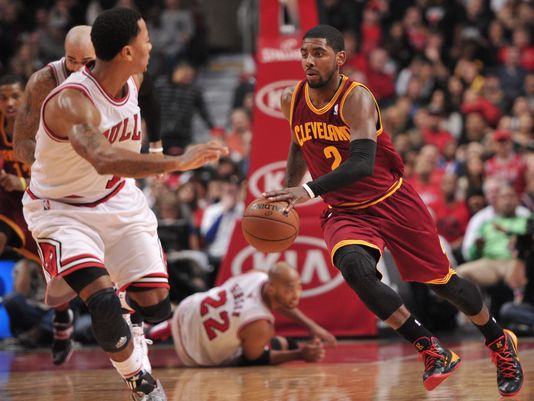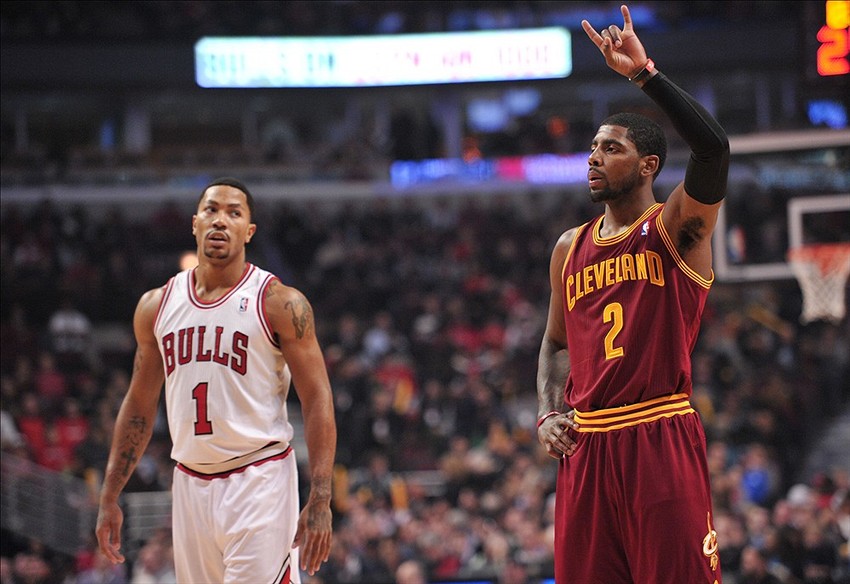
Rob Grabowski | USA Today Sports
By the end of the 2010-11 NBA season there was no doubt who the best Point Guard in the league was: Derrick Rose. He won the MVP that season, becoming the first PG since Steve Nash in 2006 to hoist the award and the third since 1973 to record 2,000 points and 600 assists in a single season.
The Cavs won the lottery and drafted Duke PG Kyrie Irving that summer with the number one overall draft pick. Coming out of the draft, it was easy to see the comparisons to the newly crowned MVP. Now, three and a half seasons of basketball later and the tides have turned. Look to last summer, when Irving led the USA Men’s National Team to a FIBA World Cup Championship in an MVP performance while Rose never received a callback from the team. Obviously there’s bias, but this shift in PG dominance is gradually becoming more ubiquitous. No longer is DRose the force that he was a few years ago, and Kyrie is blossoming into a premiere NBA Point Guard with impalpable talent.
Kyrie does a lot of things that remind fans of that magical season that Rose had, and he continues to prove that he does a lot of things better.
Continue to the next page!

Jamie Sabau | Getty Images
1. The Most Obvious: Staying Healthy
As Kyrie developed throughout his rookie season into his sophomore year, showing the ability to stay healthy after his short, questionable stint at Duke. However, since Kyrie entered the NBA, he has played in a total of 219 games, including 38 of the Cavs’ 41 this season. Rose, on the other hand, has compiled just 80 games in that stretch, including the whole ’12-’13 season that he missed, and just 31 of 42 games for the Bulls this season.
It’s not just the number of games that they are appearing in, but more so the minutes on court. Irving averages just over 38 minutes a game this year, while Rose averages just under 30.
While both stars give it all when they are on the court and seem injury-prone due to their fearlessness and intangible (yet risky) style, it appears that Rose’s sustainability is less than Irving’s.
Continue to the next page!

NBA
2. Getting to the Line
Point Guards don’t get to the free throw line nearly as much, nor are they expected to, as their bigger counterparts in the frontcourt. That does not mean that these few trips to the line are not crucial though.
Kyrie gets roughly five attempts at the line a game, converting on 85 percent of those attempts. Rose shoots less than four shots at the line throughout a game and makes 79 percent of those shots.
Those numbers are not staggeringly different, but it does prove a few things. Kyrie is getting a little more physical when he drives to the rim than Rose. Also, in the final seconds of the game when the ball is inbounded to a PG to ice the game, who would you rather have shooting two free throws?
Kyrie.
Continue to the next page!

Charles Rex | AP
3. Turnovers
Point Guards are the facilitators of the offense. Their job is to protect the ball, spread it around the offense, and create opportunities to score. If the ball is going into defenses hands prematurely, the PG isn’t doing their job correctly.
Kyrie is averaging almost one turnover less than DRose per game, and even though that statistic represents a small gap, keep in mind that Rose is averaging about ten less minutes per game. Kyrie is on the floor longer and turning it over less.
Continue to the next page!

Rob Grabowski | Getty Images
4. Beyond the Arch
Unless you are Russell Westbrook, it is usually frowned upon for a PG to spot up and take a three. However, if you get an open look, take the shot, and PG’s tend to have high percentages from beyond the arch.
Rose is averaging 30 percent from downtown this year, while Kyrie is keeping up with his career average at 37 percent. That seven percent margin is huge, but looking even deeper behind those numbers, there is another stat that shows that Irving is winning the three-point battle with Rose.
Irving puts up less threes per game than Rose and still averages more points per game with the long ball. In turn, less wasted possessions, more points, and better percentages.
Kyrie is taking smarter looks than Rose when it comes to the deep ball.
Continue to the next page!

Charles Rex | AP
5. Steals
While neither PG can claim that they are outstanding defenders, Irving takes away the ball from the other team one more time per game than Rose this season. So Irving not only turns the ball over less, but he takes it away more as well.
Continue to the next page!
Scott Strazzante | Tribune
6. Points Per Game in Terms of Team Needs
This category may seem like an odd one as Rose’s Bulls are 27-15 and the Cavs are 21-20, but in terms of the sweet spot of PPG that a PG should be at for each perspective team, Kyrie is doing his part, and Rose is not quite at his mark. Look for this to become more of a factor as the playoffs approach.
Looking at Rose’s MVP season and Chicago’s best season since the Jordan years, Rose averaged 25 PPG. This season, he is only at 18; albeit that number may seem like a wash because he was playing more minutes during his team’s 62 game winning season, but the fact is that in order for the Bulls to be the caliber that they were during that phenomenal year, Rose needs to be doing more when it comes to getting to the bucket.
On the other side, Kyrie is averaging 21 PPG this season, which remarkably enough, is right by his career average. This means something because with the best player in the world on the squad, Kyrie has maintained his game at the level that his was prior to LeBron arriving. He knows his role and has not changed the way he has played the game, which is a benefit to his development.
Continue to the next page!
Scott Strazzante | Tribune
7. Ball Handling
In terms of flashiness, DRose was a staple back in his earlier years, but after being plagued by injury, his ankle breaking moves have been toned down a bit.
However, Kyrie does things with the ball that are out of this world. At times, it looks like a basketball is just a part of his body. What comes as difficult for the average ball handler, Kyrie makes it look routine and simple enough to the point where you have to slow it down to see what exactly he did to get to the basket, find an open teammate or confuse a defender to create an open shot for himself.
Words are not needed to describe how jaw dropping Kyrie’s ball handling skills have become. And he is only halfway through his fourth year in the NBA.
Continue to the next page!

Gary Dineen | Getty Images
8. Age
Through their first three seasons in the NBA, both Rose and Irving averaged approximately 20 points, six assists and four rebounds. The only difference, negating Rose’s decimally higher rebounding and assists averages, is that Irving accrued an extra steal per game while playing a 4.4 fewer minutes in each contest. Four years younger than Derrick Rose while evolving into an All Star Point Guard with his own shoe line by the age of 22, Kyrie Irving will forever have youth and potential on his side in this debate.
